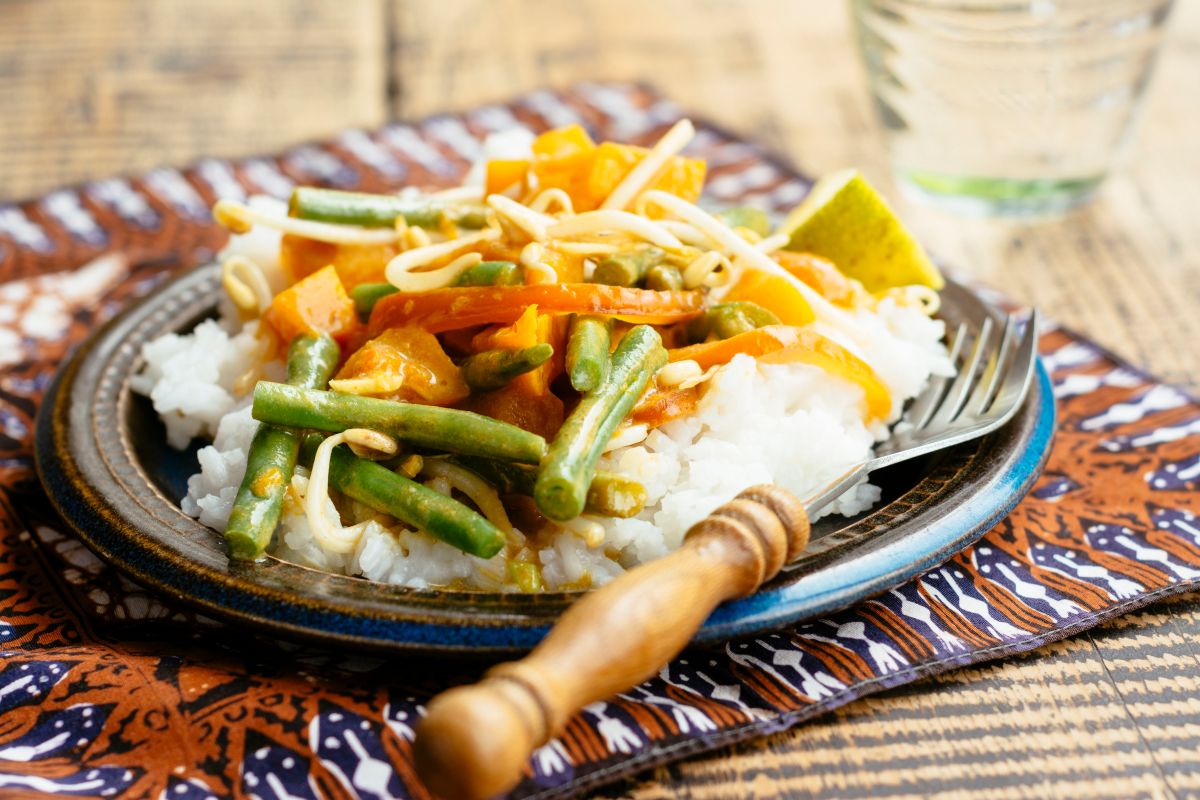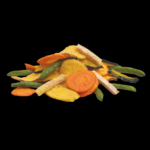Craving the vibrant flavors of Thai takeout but need to avoid soy? This culinary journey unveils the secrets to recreating your favorite dishes—Pad See Ew, Green Curry, and more—without compromising on taste or authenticity. We’ll explore simple soy-free substitutions, detailed recipes with vivid step-by-step instructions, and expert tips to elevate your home-cooked Thai food to restaurant-quality levels. Prepare to embark on a flavorful adventure, where each bite is a testament to the delicious possibilities of soy-free Thai cooking.
From understanding common soy-based ingredients and their readily available alternatives to mastering the art of balancing flavors without soy sauce, this guide empowers you to confidently navigate the world of soy-free Thai cuisine. Discover how to adapt existing recipes, source high-quality ingredients, and build a pantry stocked with essential staples for effortless soy-free Thai cooking at home. Get ready to transform your kitchen into a vibrant Thai eatery, one delicious dish at a time.
Soy-Free Ingredient Substitutions

Creating delicious and authentic soy-free Thai food requires careful consideration of ingredient substitutions. Many traditional Thai recipes rely on soy sauce, soy milk, and other soy-based products for their umami depth and creamy textures. Successfully navigating these substitutions involves understanding the role soy plays in each dish and selecting appropriate alternatives that mimic its contribution without compromising the overall flavor profile.
Soy sauce, a cornerstone of many Thai dishes, provides saltiness and a characteristic savory depth. Its impact on the final product is significant, affecting both the taste and the overall balance of the dish. Substituting soy sauce requires careful attention to both flavor and salt content.
Soy Sauce Alternatives
Several soy-free alternatives can effectively replace soy sauce in Thai cooking. Tamari, although technically a type of soy sauce, is often gluten-free and can be a suitable option for those with mild soy sensitivities. Coconut aminos, derived from coconut sap, offer a similar salty and umami flavor profile, though with a slightly sweeter undertone. For a bolder, more savory taste, fish sauce is a traditional choice in many Southeast Asian cuisines, offering a briny, pungent depth that complements many Thai dishes. Finally, a combination of salt, mushroom powder, and seaweed flakes can create a surprisingly effective umami substitute. The key is to experiment with different ratios to achieve the desired saltiness and depth of flavor.
Soy Milk Alternatives
Soy milk, often used in creamy Thai soups and curries, provides both body and a subtle sweetness. Its absence requires substituting ingredients that offer similar textural and flavor contributions. Coconut milk, a staple in many Thai dishes, provides a rich, creamy texture and a slightly sweet flavor that complements many curries and soups. Other alternatives include cashew cream (made by blending soaked cashews), almond milk, or even full-fat coconut cream for richer applications. The choice depends on the desired level of creaminess and the overall flavor profile of the dish. For instance, cashew cream might be preferred in dishes where a nuttier flavor is desired, while almond milk could offer a lighter, less intense option.
Challenges in Soy-Free Thai Cooking
Finding suitable soy-free alternatives can present some challenges. While coconut aminos and tamari are readily available in many supermarkets, specialized ingredients like certain types of mushroom powder or seaweed flakes may require sourcing from Asian grocery stores or online retailers. Moreover, the taste and texture of the alternatives may not perfectly replicate soy-based ingredients. Experimentation and adjustment of seasonings are often necessary to achieve the desired balance of flavors. For example, coconut aminos’ sweetness might require a slight increase in the amount of other seasonings to compensate. Furthermore, the cost of some soy-free alternatives can be higher than soy-based options, impacting the overall budget of the meal preparation.
Step-by-Step Soy-Free Thai Recipes
This section provides detailed, step-by-step instructions for creating delicious and authentic soy-free Thai dishes. Each recipe includes descriptions of the visual aspects at each stage, allowing you to easily follow along and recreate these flavorful meals in your own kitchen. Remember to always taste and adjust seasonings to your preference.
Soy-Free Pad See Ew
This recipe replaces the traditional soy sauce with a combination of fish sauce and brown sugar for a savory-sweet flavor profile.
- Preparing the Noodles: Begin by cooking wide rice noodles according to package directions. The image would show a pot of boiling water with noodles submerged, steaming gently. Once cooked, rinse the noodles under cold water to prevent sticking and set aside. The image would then show the glistening, separated noodles in a colander, ready for the next step.
- Stir-frying the Vegetables: Heat a wok or large skillet over medium-high heat. Add a tablespoon of oil (vegetable or coconut) and then add your sliced vegetables – typically broccoli florets, Chinese broccoli (gai lan), and sliced onions. Stir-fry until tender-crisp, approximately 3-5 minutes. The image shows brightly colored vegetables, quickly stir-fried, with a slight sheen from the oil.
- Adding the Protein: Add your protein of choice (chicken, pork, or tofu) to the wok and cook until browned and heated through. The image shows the protein, nicely browned and slightly charred at the edges, mixed in with the vegetables.
- The Sauce: In a small bowl, whisk together 2 tablespoons of fish sauce, 1 tablespoon of brown sugar, 1 tablespoon of oyster sauce (ensure it’s soy-free!), and a teaspoon of white pepper. The image would show a small bowl with the dark, glossy sauce, ready to be added to the wok.
- Combining and Finishing: Pour the sauce over the vegetables and protein, and stir to coat evenly. Add the cooked noodles and toss gently to combine. Continue to cook for another 2-3 minutes, until the noodles are heated through and coated in the sauce. The image would display the finished dish – noodles glistening with sauce, vegetables vibrant, and the protein integrated throughout.
Soy-Free Green Curry
This vibrant curry relies on a rich blend of aromatic ingredients and coconut milk for its creamy texture and flavor.
- Sautéing Aromatics: Heat coconut oil in a pot or wok over medium heat. Add minced garlic, ginger, lemongrass (bruised), and green chilies. Sauté until fragrant, about 2 minutes. The image depicts the aromatic ingredients sizzling gently in the oil, releasing their fragrant steam.
- Adding Curry Paste: Stir in your favorite green curry paste (ensure it’s soy-free). Cook for another minute, stirring constantly, until fragrant. The image shows the vibrant green curry paste being mixed into the aromatic base, creating a rich, fragrant paste.
- Coconut Milk and Vegetables: Pour in coconut milk and bring to a simmer. Add your chosen vegetables (bamboo shoots, bell peppers, eggplant, zucchini). Simmer until the vegetables are tender, about 5-7 minutes. The image shows the creamy coconut milk simmering gently with colorful vegetables, their textures softened.
- Protein and Seasoning: Add your protein (chicken, tofu, or vegetables) and simmer until cooked through. Season with fish sauce (to taste), lime juice, and sugar (to taste). The image displays the finished curry, with the protein and vegetables simmering in the rich green coconut milk, ready to be served.
Soy-Free Tom Kha Soup
This fragrant and creamy soup is a delightful alternative to Tom Yum, substituting coconut milk for the traditional broth base.
- Infusing the Broth: In a pot, combine coconut milk, chicken broth (or vegetable broth for a vegetarian option), lemongrass (bruised), galangal (sliced), and kaffir lime leaves. Bring to a simmer over medium heat. The image shows the simmering broth, infused with aromatic herbs and spices, creating a fragrant steam.
- Adding Aromatics: Add minced garlic, ginger, and chilies (adjust to your spice preference). Simmer for another 5 minutes to allow the flavors to meld. The image shows the added aromatics simmering gently in the creamy broth, their flavors melding together.
- Mushrooms and Protein: Add sliced mushrooms (shiitake or cremini) and your protein of choice (chicken, shrimp, or tofu). Simmer until the protein is cooked through and the mushrooms are tender. The image displays the addition of protein and mushrooms, creating a more substantial and visually appealing soup.
- Finishing Touches: Season with fish sauce (to taste), lime juice, and sugar (to taste). Garnish with fresh cilantro and lime wedges before serving. The image shows the finished soup, garnished with fresh cilantro and a lime wedge, ready to be served.
Adapting Existing Recipes
Transforming beloved Thai dishes into soy-free versions requires careful consideration, but the results are well worth the effort. The vibrant flavors of Thai cuisine can be beautifully preserved even without soy sauce, relying instead on a symphony of other aromatic ingredients. This section details practical methods for adapting existing recipes, focusing on maintaining authenticity while eliminating soy.
Adapting a standard Thai Red Curry recipe, for instance, necessitates a thoughtful substitution for soy sauce’s umami depth and salty tang. The key lies in layering flavors to achieve a similar complexity.
Modifying a Thai Red Curry Recipe
A traditional Thai Red Curry relies heavily on soy sauce for its savory depth. To create a soy-free version that remains authentic, we can substitute fish sauce, a staple in Thai cooking, for a portion of the soy sauce’s saltiness and umami. Tamarind paste adds a delightful sourness and depth, balancing the spices. A touch of brown sugar can provide a subtle sweetness that complements the other flavors. The exact ratios depend on personal preference and the specific recipe, but a good starting point might involve replacing half the soy sauce with fish sauce and adding a teaspoon of tamarind paste and a half-teaspoon of brown sugar per cup of replaced soy sauce. The richness and umami can further be enhanced by using coconut aminos, a soy-free alternative derived from coconut sap, or a splash of mushroom broth for added depth.
Adapting Pre-Made Thai Curry Pastes
Many pre-made Thai curry pastes contain soy sauce or soy-based ingredients as preservatives or flavor enhancers. To ensure soy-free cooking, carefully read the ingredient list of any pre-made paste before using it. If a paste contains soy, one must seek out soy-free alternatives. Many Asian grocery stores now stock a wide variety of soy-free curry pastes, often clearly labeled as such. Alternatively, making your own curry paste from scratch provides complete control over ingredients and guarantees a soy-free product. This allows for customization of spice levels and the incorporation of desired fresh herbs and aromatics. The process of making a paste from scratch is slightly more time-consuming, but offers a more authentic and tailored culinary experience.
Adjusting Seasoning and Flavor Profile
The absence of soy sauce necessitates a strategic adjustment of the overall seasoning and flavor profile. The primary goal is to replace soy sauce’s contribution of saltiness, umami, and depth. Fish sauce provides a comparable salty and umami component. Lime juice or tamarind paste can add brightness and acidity to balance the richness of coconut milk. Palm sugar or brown sugar can contribute a subtle sweetness to harmonize the overall flavor profile. Finally, mushroom broth or a vegetable stock adds a savory depth that mirrors the umami characteristics of soy sauce. Experimentation is key; start with small adjustments and taste frequently to achieve the desired balance. Remember that the spices themselves—red chilies, galangal, lemongrass, and kaffir lime leaves—contribute significantly to the overall flavor profile, so don’t be afraid to let their aromatic complexity shine. The careful layering of these alternative ingredients will create a delicious and authentic soy-free Thai dish.
Mastering the art of soy-free Thai cooking opens a world of culinary creativity and delicious possibilities. With a little knowledge and the right techniques, you can recreate the authentic flavors of your favorite takeout meals without compromising on taste or health. This guide has equipped you with the essential tools—from ingredient substitutions and detailed recipes to expert tips and tricks—to confidently embark on this flavorful journey. So, gather your ingredients, embrace the vibrant spices, and prepare to delight your taste buds with authentic, soy-free Thai cuisine that rivals any restaurant.
FAQ Compilation
Can I use tamari instead of soy sauce in Thai recipes?
Tamari is soy-based, so it’s not suitable for soy-free diets. Use coconut aminos or a combination of fish sauce and lime juice as alternatives.
Are all Thai curry pastes soy-free?
No, many contain soy sauce or soy-based ingredients. Always check the ingredient list carefully before purchasing.
What are some good soy-free alternatives to soy sauce for flavor?
Coconut aminos offer a similar salty umami flavor, while a combination of fish sauce, lime juice, and brown sugar can create a complex, savory profile.
How do I ensure my Thai dishes are truly soy-free?
Always read ingredient labels meticulously, and when eating out, clearly communicate your soy allergy to restaurant staff.


